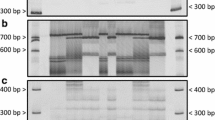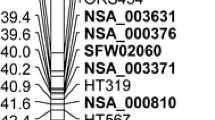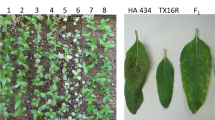Abstract
Sunflower rust, caused by the fungus Puccinia helianthi Schwein., was not a serious problem for many decades because of successful deployment of effective resistance genes in commercial sunflower (Helianthus annuus L.) hybrids in North America. In the 1980s and early 1990s, however, a shift in virulence of the rust race population in North America rendered most of the commercial hybrids susceptible to new virulent races. A germplasm line, HA-R2, carrying the rust resistance gene R 5 was released as a multi-race rust-resistant line in 1985 but has not been widely used in commercial hybrid production. R 5 remains effective against the prevalent rust races of sunflower in North America. This gene was previously reported to be associated with two simple sequence repeat (SSR) markers, ORS316 and ORS630, which were mapped to linkage group (LG) 13 of sunflower. However, out of the 63 markers of LG13 screened in the present study, only 18, including ORS316 and ORS630, were polymorphic. These markers, which covered all of LG 13, were assayed in 94 individual F2 progenies derived from the cross of HA 89 with HA-R2. All failed to detect any locus in LG13 associated with the gene R 5 . Subsequently, a bulked segregant analysis was employed with an additional 510 SSR markers selected from the remaining 16 LGs of the sunflower genome. This analysis demonstrated that the LG2 markers showed association with rust resistance. Genotyping of the 94 F2 individuals with 23 polymorphic SSR markers from LG2 confirmed the R 5 location on LG2, flanked by two SSR markers, ORS1197-2 and ORS653a, at 3.3 and 1.8 cM of genetic distance, respectively. The markers for R 5 developed in this study will provide a useful tool for speeding up deployment of the R 5 gene in commercial sunflower hybrid production.



Similar content being viewed by others
References
Burke JM, Tang S, Knapp SJ, Rieseberg LH (2002) Genetic analysis of sunflower domestication. Genetics 161:1257–1267
de Romano AB, Vázquez AN (2003) Origin of the Argentine sunflower varieties. Helia 26:127–136
Dußle CM, Hahn V, Knapp SJ, Bauer E (2004) Pl Arg from Helianthus argophyllus is unlinked to other known downy mildew resistance genes in sunflower. Theor Appl Genet 109:1083–1086
Dvorak J, Knott DR (1990) Location of a Triticum speltoides chromosome segment conferring resistance to leaf rust in Triticum aestivum. Genome 33:892–897
Faris JD, Haen KM, Gill BS (2000) Saturation mapping of a gene-rich recombination hot spot region in wheat. Genetics 154:823–835
Feng J, Jan CC (2008) Introgression and molecular tagging of Rf4, a new male fertility restoration gene from wild sunflower Helianthus maximiliani L. Theor Appl Genet 117:241–249
Gill BS, Hatchett JH, Raupp WJ (1987) Chromosomal mapping of Hessian Fly resistance gene H13 in the D genome of wheat. J Hered 78:97–100
Gill KS, Gill BS, Endo TR, Boiko EV (1996a) Identification and high-density mapping of gene-rich regions in chromosome group 5 of wheat. Genetics 143:1001–1012
Gill KS, Gill BS, Endo TR, Taylor T (1996b) Identification and high-density mapping of gene-rich regions in chromosome group 1 of wheat. Genetics 144:1883–1891
Gulya TJ (1985) Registration of five disease–resistant sunflower germplasms. Crop Sci 25:719–720
Gulya TJ (1997) Sunflower rust races in the United States in 1996. Phytopathology 87:S36
Gulya TJ (2006) The sunflower rust situation: current races in the northern and central Great Plains, and resistance in oilseed and confection hybrids. In: Proceedings of 28th sunflower research workshop. Fargo, ND. 11–12 Jan 2006. Available at http://www.sunflowernsa.com/research/research-workshop/documents/Gulya_Rust_06.pdf
Gulya TJ, Markell S (2009) Sunflower rust status—2008. Race frequency across the midwest and resistance among commercial hybrids. Available at http://www.sunflowernsa.com/uploads/Gulya_RustStatus_09.pdf
Gulya TJ, Masirevic S (1996) Inoculation and evaluation methods for sunflower rust. In: Proceedings of 18th sunflower research workshop. Fargo, ND, 11–12 Jan 1996, pp 31–38
Gulya TJ, Viranyi F (1994) Virulent new races of sunflower rust (Puccinia helianthi) from the southern great plains. In: Proceedings of 16th sunflower research workshop. Fargo, ND, 13–14 Jan, pp 94–98
Gulya TJ, Miller J, Rashid K (1989) Rust races occurring in North America in 1988 and resistance of sunflower hybrids to race 1 and 3. In: Proceedings of sunflower research workshop. Fargo, ND, 9–10 Jan, pp 19–22
Gulya TJ, Venette R, Venette JR, Lamey HA (1990) Sunflower rust. NDSU Ext Ser Bull. PP-998 Fargo, ND. http://www.ag.ndsu.edu/pubs/plantsci/rowcrops/pp998w.htm
Gulya TJ, Kong G, Brothers M (2000) Rust resistance in wild Helianthus annuus and variation by geographic origin. In: Proceedings of 15th international sunflower conference. Toulouse, France, 12–15 June 2000, pp I38–I42
Hennessy CM, Sackston WE (1972) Studies on sunflower rust. X. Specialization of Puccinia helianthi on wild sunflowers in Texas. Can J Bot 50:1871–1877
Horne EC, Kumpatla SE, Patterson KA, Gupta M, Thompson SA (2004) Improved high-throughput sunflower and cotton genomic DNA extraction and PCR fidelity. Plant Mol Biol Rep 22:83–84 Biology r 22:83–84
Huang L, Gill BS (2001) An RGA-like marker detects all known Lr21 leaf rust-resistance gene family members in Aegilops tauschii and wheat. Theor Appl Genet 103:1007–1013
Hulke BS, Miller JF, Gulya TJ (2010) Registration of the restorer oilseed sunflower germplasm RHA 464 possessing genes for resistance to downy mildew and sunflower rust. J Plant Registr 4:249–254
Jan CC, Gulya TJ (2006) Registration of a sunflower germplasm resistant to rust, downy mildew and virus. Crop Sci 46:1829
Jan CC, Quresh Z, Gulya TJ (2004) Registration of seven rust resistance sunflower germplasms. Crop Sci 44:1887–1888
Kosambi DD (1944) The estimation of map distances from recombination values. Ann Eugen 12:172–175
Lander ES, Green P, Abrahamson J, Barlow A, Daly MJ, Lincoln SE, Newburg L (1987) MAPMAKER: an interactive computer package for constructing primary genetic maps of experimental and natural population. Genomics 1:174–181
Lawson WR, Jan CC, Shatte T, Smith L, Kong GA, Kochman JK (2010) DNA markers linked to the R 2 rust resistance gene in sunflower (Helianthus annuus L.) facilitate anticipatory breeding for this disease variant. Mol Breed. doi: 10.1007/s11032-010-9506-1
McIntosh RA, Friebe B, Jiang J, The D, Gill BS (1995) Cytogenetical studies in wheat XVI. Chromosome location of a gene for resistance to leaf rust in a Japanese wheatrye translocation line. Euphytica 82:141–147
Miah MAJ, Sackston WE (1970) Genetics of host-pathogen interaction in sunflower. Phytoprotection 51:1–16
Michelmore RW, Paran I, Kesseli RV (1991) Identification of markers linked to disease-resistance genes by bulked segregant analysis: a rapid method to detect markers in specific genomic regions by using segregating populations. Proc Natl Acad Sci USA 88:9828–9832
Miller JF, Gulya TJ (2001) Registration of three rust resistant sunflower germplasm populations. Crop Sci 41:601
Miller JF, Rodriguez RH, Gulya TJ (1988) Evaluation of genetic materials for inheritance of resistance to Race 4 rust in sunflower. In: Proceedings of 12th international sunflower conference, Novi Sad, Yugoslavia. 25–29 July 1988. International Sunflower Association, Paris, pp 361–365
Putt ED, Sackston WE (1957) Studies on sunflower rust. I. Some sources of rust resistance. Can J Plant Sci 37:43–54
Putt ED, Sackston WE (1963) Studies on sunflower rust. IV. Two genes, R 1 and R 2 for resistance in the host. Can J Plant Sci 43:490–496
Qi LL, Gulya TJ, Seiler GJ, Hulke BS, Vick BA (2011a) Identification of resistance to new virulent races of rust in sunflowers and validation of DNA markers in the gene pool. Phytopathology 101:241–249
Qi LL, Hulke BS, Vick BA, Gulya TJ (2011b) Molecular mapping of the rust resistance gene R 4 to a large NBS-LRR cluster on linkage group 13 of sunflower. Theor Appl Genet 123:351–358. doi:10.1007/s00122-011-1588-6
Quresh Z, Jan CC, Gulya TJ (1993) Resistance to sunflower rust and its inheritance in wild sunflower species. Plant Breed 110:297–306
Ramsay L, Macaulay M, degli Ivanissevich S, MacLean K, Cardle L, Fuller J, Edwards KJ, Tuvesson S, Morgante M, Massari A, Maestri E, Marmiroli N, Sjakste T, Ganal M, Powell W, Waugh R (2000) A simple sequence repeat-based linkage map of barley. Genetics 156:1997–2005
Rashid KY (2006) Sunflower rust races in Manitoba. Available at http://www.umanitoba.ca/afs/agronomists_conf/proceedings/2006/Rashid_sunflower_rust_races.pdf (verified 03 August 2010)
Rowland GG, Kerber ER (1974) Telocentric mapping in hexaploid wheat of genes for leaf rust resistance and other characters derived from Aegilops squarrosa. Can J Genet Cytol 16:137–144
Sackston WE (1962) Studies on sunflower rust. III. Occurrence, distribution, and significance of race Puccinia helianthi Schw. Can J Bot 40:1449–1458
Sears ER (1961) Identification of the wheat chromosome carrying leaf rust resistance from Aegilops umbellulata. Wheat Inf Serv 12:12–13
Sears ER (1966) Chromosome mapping with the aid of telocentrics. In: MacKey J (ed) Proceedings of 2nd international wheat genetetics symposium. Hereditas Suppl. Vol, Lund, Sweden, pp 370–381
See DR, Brooks SA, Nelson JC, Brown-Guedira GL, Friebe B, Gill BS (2006) Gene evolution at the ends of wheat chromosomes. Proc Natl Acad Sci USA 103:4162–4167
Seiler GJ (2010) Utilization of wild Helianthus species in breeding for disease resistance. In: Proceedings of international symposium “sunflower breeding on resistance to diseases”. Krasnodar, Russia, 23–24 June 2010, pp 37–51
Sendall BC, Kong GA, Goulter KC, Aitken EAB, Thompson SM, Mitchell JHM, Kochman JK, Lawson W, Shatte T, Gulya TJ (2006) Diversity in the sunflower: Puccinia helianthi pathosystem in Australia. Australas Plant Path 35:657–670
Tang S, Yu JK, Slabaugh MB, Shintani DK, Knapp SJ (2002) Simple sequence repeat map of the sunflower genome. Theor Appl Genet 105:1124–1136
Tang S, Kishore VK, Knapp SJ (2003) PCR-multiplexes for a genome-wide framework of simple sequence repeat marker loci in cultivated sunflower. Theor Appl Genet 107:6–19
Tanksley SD, Ganal MW, Prince JP, de-Vicente MC, Bonierbale MW, Broun P, Fulton TM, Giovannoni JJ, Grandillo S, Martin GB, Messeguer R, Miller JC, Miller L, Paterson AH, Pineda O, Roder MS, Wing RA, Wu W, Young ND (1992) High density molecular linkage maps of the tomato and potato genomes. Genetics 132:1141–1160
Yang SM, Antonelli EF, Luciano A, Luciani ND (1986) Reactions of Argentine and Australian sunflower rust differentials to four North American cultures of Puccinia helianthi from North Dakota. Plant Dis 70:883–886
Yu JK, Tang S, Slabaugh MB, Heesacker A, Cole G, Herring M et al (2003) Towards a saturated molecular genetic linkage map for cultivated sunflower. Crop Sci 43:367–387
Zimmer DE, Rehder D (1976) Rust resistance of wild Helianthus species of the north central United States. Phytopathology 66:208–211
Acknowledgments
We thank Drs. Shiaoman Chao and Gerald Seiler for critical review of the manuscript, and Angelia Hogness and Megan Ramsett for technical assistance. This project was supported by the USDA-ARS CRIS Project No. 5442-21000-034-00D.
Author information
Authors and Affiliations
Corresponding author
Additional information
Mention of trade names or commercial products in this article is solely for the purpose of providing specific information and does not imply recommendation or endorsement by the U.S. Department of Agriculture. USDA is an equal opportunity provider and employer.
Rights and permissions
About this article
Cite this article
Qi, L.L., Gulya, T.J., Hulke, B.S. et al. Chromosome location, DNA markers and rust resistance of the sunflower gene R 5 . Mol Breeding 30, 745–756 (2012). https://doi.org/10.1007/s11032-011-9659-6
Received:
Accepted:
Published:
Issue Date:
DOI: https://doi.org/10.1007/s11032-011-9659-6




